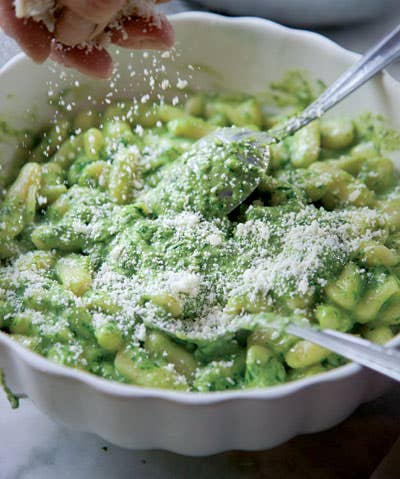
Pesto Goes Global
From its humble beginnings in Liguria, pesto has gone far: not only can you find it in jarred form all around the world, but it's used to flavor everything from pizzas to fast-food sandwiches to chips. It's now a household name, up there with marinara and mayonnaise. But unlike those sauces, pesto has always conferred a certain gourmet status in the States; its rise in popularity in the 1980s coincided with the period when Americans started exploring regional Italian cooking and embracing all things Mediterranean. With its fresh basil, extra-virgin olive oil, aged Parmigiano-Reggiano, and exotic pine nuts—all newly fetishized ingredients sold at specialty food stores such as Dean & DeLuca in New York City—pesto was perfectly poised to become the poster child of a new foodie movement. Though it was often served the traditional way, tossed with pasta or gnocchi, home cooks, chefs, and caterers added pesto to everything from tuna to orzo salad (that staple of the prepared-food section, a growing category in supermarkets at the time). It was slathered on bruschetta, layered with goat cheese or mascarpone and sun-dried tomatoes or roasted red peppers to make tricolored torta, and tossed with vegetables. "Pesto is the quiche of the '80s," Nora Ephron wrote in her screenplay for the 1989 film When Harry Met Sally, and she was right: When Sheila Lukins and Julie Rosso published The Silver Palate Cookbook (Workman) in 1979, they included just one recipe for pesto and another for pasta with pesto. When that volume went on to become a bible for American epicures, their follow-up, The New Basics (Workman, 1989), devoted four pages to the sauce, with recipes for making everything from black bean pesto to peanut pesto, and tips for using these pestos to season potatoes, nachos, grilled fish, aioli (another emblem of the 1980s), and more. The fallout from pesto's overwhelming popularity is that the simple beauty of the original was often lost. But the pesto period, as over the top as it often was, marked a turning point in American cuisine, when cooks started embracing, and experimenting with, regional recipes. Today, it remains a hallmark of our culinary flexibility.
Keep Reading
Continue to Next Story










